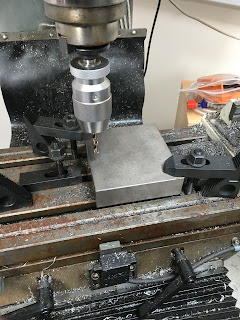As well as the pukka ISO40 toolholders I've acquired for The Shiz, I also got 20 or so assorted BT40 toolholders from John Stevenson not so long ago. As they won't fit the machine in their undoctored state, I planned to TIG weld some M16 threaded collars to the small end of the taper and thus make ISO40 ones out of them. Nothing to lose, as they are not usable in their current form, yet I can't imagine bothering to sell them on. And there are some useful toolholders in there. mainly ER32 collet chucks but also a couple of ER16 collet chucks and a 12mm end mill holder.
There are a few other odds and sods such as a U Drill of unknown parentage and what look like Clarkson Autolock chucks. I also got a speeder from John that speeds up the spindle by 3:1 (max speed 10krpm), that takes an ER11 collet. Although it looks like ISO40, it actually has an imperial thread. John's machine was a Beaver which had a pullstud system, so the thread wasn't critical. To use this on my machine, I'll have to chop the end off and weld a new (M16) collar on the end. It's either that or scrap it, so again I have nothing to use.
So I chopped up the remaining piece of MDF (originally 2' x 4') and marked it out for a shit load of 44mm holes. Those bimetal hole cutters are fine - or would be if they didn't clog up every few mm of hole. That requires you to withdraw the tool and brush the teeth clear with a steel brush unless you like the smell of burning MDF.
First, an 8-position tool rack for The Shiz, to take the tools for the current job.
Next will come a 30 position rack for ISO40 tools.....
As for the BT40 >> ISO40 transformation, here are some of the aforementioned BT40 toolholders and some collars I made up on the Bantam. There's also an ISO40 example (red collar) for them to live up to.
The collars have an internal M16 thread and are slightly less than 25mm dia. I think the formal dimension is probably 25mm or 25.4mm but it has no direct function other than to contain the drawbar thread, so it seemed sensible to make it a shade under, to allow for distortion and eccentricity in the collar and the welding operation. The length isn't critical but is typically about 25mm too. I put a heavy chamfer on each end to help with the weld on one end and for the drawbar entry on the other.
I used an M16 hex socket grub screw to align and clamp the collar and toolholder together (not the Chinesium bolt in the picture, which is as wonky as f**k), then tack welded them. Then removed the grub screw and finished the welds. No need to fully weld around the circumference. Finally, file any proud weld material down flush.
Looks
Talking of John Stevenson, we heard that he died this morning, having acquired an infection following a bone marrow transplant. Bugger. He was a nice guy, generous with his time and advice and someone who simply got on with stuff rather than blather about it. His family must be grief stricken obviously.






















































